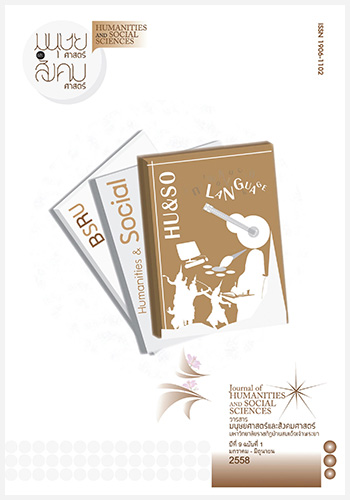The Use of Augmented Reality to Develop the Learning Media for Thai Lessons of Primary 2
Keywords:
Augmented Reality, Learning Media for Thai Lessons, Learning Media DevelopmentAbstract
The purposes of this research were to develop the learning media of Thai lessons for Primary 2 using augmented reality according to the performance criteria of 80/80. The Learning Media for Thai lessons using augmented reality of primary 2 is developed as a tool in order to help learning and teaching Thai learning by focusing on working on tablet to make the instruction more interesting and encourage more participation from the students. The developed learning media are divided into two parts: 1) the augmented reality with the text, animation and sound being displayed in real time based on the real world that merges the world of reality and virtual reality together and 2) the quiz is an application that runs on an Android and users can choose the test by themselves. The samples in this research were Primary 2 students (Grade 2) who enrolled in the second semester of academic year 2014 at Banhuaimafai School, Chonburi Province. The research instruments consisted of the performance evaluation of electronic media by using augmented reality, learning achievement of the students before and after the learning. The statistics used in this research was the E1/E2, mean and standard deviation. The result of this research found that the developed learning media for Thai lessons is suitable at the highest level in all (Mean = 4.74, S.D. = 0.27). The efficiency was 82.12/86.21 which was higher than the criteria set (80/80). in comparing the student’s achievement, it was found that the student achieved learning progress significantly at level of .05. Finally, the effectivenesss index was 0.67.
References
กระทรวงศึกษาธิการ. (2551). หลักสูตรการศึกษาขั้นพื้นฐาน พุทธศักราช 2551. กรุงเทพฯ : ชุมนุมสหกรณ์การเกษตรแห่งประเทศไทย.
กระทรวงศึกษาธิการ. (2554). โครงการแท็บเล็ตพีซีเพื่อการศึกษาไทย. ค้นเมื่อวันที่ 12 ตุลาคม 2557. จาก http://www.otpc.in.th
กานดา พูนลาภทวี. (2530). สถิติเพื่อการวิจัย. กรุงเทพฯ : ฟิสิกส์เซ็นเตอร์.
ชัยยงค์ พรหมวงศ์ และคนอื่นๆ. (2540). ระบบสื่อการสอน เอกสารการสอนชุดวิชาเทคโนโลยี และสื่อสารศึกษา หน่วยที่ 1-5. (พิมพ์ครั้งที่ 20). กรุงเทพฯ : โรงพิมพ์ไตเต็ด.
นุชนารถ บัวพันธุ์. (2551). รายงานผลการสร้างและพัฒนาเอกสารประกอบการเรียนการสอน วิชา ง 30101 งานบ้าน ชั้นมัธยมศึกษาปีที่ 1 เรื่อง อาหารจานเดียวพื้นเมืองตราด โรงเรียนสตรีประเสริฐศิลป์. ตราด : สำนักงานเขตพื้นที่การศึกษาตราด.
บุญชม ศรีสะอาด. (2545). การวิจัยเบื้องต้น. (พิมพ์ครั้งที่ 2). กรุงเทพฯ : สุวีริยาสาสน์.
พิกุล ปักษ์สังคะเนย์. (2554). การพัฒนาบทเรียนคอมพิวเตอร์ช่วยสอน เรื่อง ชีวิตพืชและสัตว์ กลุ่มสาระการเรียนรู้วิทยาศาสตร์ สาหรับนักเรียนระดับชั้นประถมศึกษาปีที่ 2. วิทยานิพนธ์ครุศาสตรมหาบัณฑิต สาขาวิชาหลักสูตรและการสอนมหาวิทยาลัยราชภัฏมหาสารคาม.
ไพฑูรย์ ศรีฟ้า. (2553). เทคโนโลยีเสมือนจริง. ค้นเมื่อวันที่ 29 กันยายน 2557. จาก http://www.drpaitoon.com/wp-content/Documents/AR/prochure.pdf
โรงเรียนบ้านห้วยมะไฟ. (2557). โครงสร้างหลักสูตรกลุ่มสาระการเรียนรู้ภาษาไทย. ชลบุรี : ม.ป.พ.
สำนักงานคณะกรรมการพัฒนาการเศรษฐกิจและสังคมแห่งชาติ. (2554). แผนพัฒนาเศรษฐกิจและสังคมแห่งชาติ ฉบับที่ 11 พ.ศ. 2555-2559. ค้นเมื่อวันที่ 8 ตุลาคม 2557. จาก http://www.nesdb.go.th
Azuma, R.T. (1997). A survey of Augmented Reality. Malibu : Hughes Research Laboratories.
Lee, H., et al. (2007). Human Machine Interface with Augmented Reality for the Network Based Mobile Robot. Korea : Korea Institute of Science and Technology.
Silva, R., Oliverira, J.C. and Giraldi, G.A. (2003). Introduction to Augmented Reality. Quitandinha : National Laboratory for Scientific Computation.
Downloads
Published
How to Cite
Issue
Section
License
Copyright (c) 2022 Faculty of Humanities and Social Sciences Bansomdejchaopraya Rajabhat University

This work is licensed under a Creative Commons Attribution-NonCommercial-NoDerivatives 4.0 International License.




